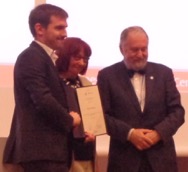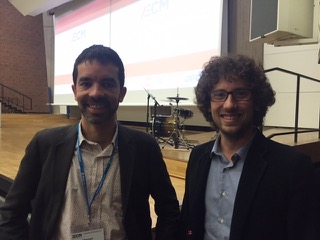Vincent Calvez and Hugo Duminil-Copin awarded the European Mathematical Society Prize and Patrice Hauret, the Felix Klein prize

Patrice Hauret, from the Centre de Technologie de Michelin was awarded the Felix Klein Prize. This prize is to be awarded to a young scientist or a small group of young scientists (normally under the age of 38) for using sophisticated methods to give an outstanding solution, which meets with the complete satisfaction of industry, to a concrete and difficult industrial problem. Patrice Hauret has crucially contributed
to the development of the modelling and simulation of tires for Michelin and he has dealt with the interaction of solids with flows (as the spinning of filaments) with multiscale-approaches, as required e.g. in the simulation of filters of any kind.

Two French mathematicians are among the ten recipients of the 2016 European Mathematical Society (EMS) prize: Vincent Calvez, chargé de recherche CNRS at the Unité de mathématiques pures et appliquées (CNRS/ENS de Lyon) and member of the Inria NuMed project team, as well as Hugo Duminil-Copin, professor at l'Université de Genève, who in September 2016 will join the Laboratoire Alexander Grothendieck (CNRS/IHES). These prizes, which are given every four years to mathematicians under 35 years of age who are from or who work in Europe, will be announced and awarded at the opening of the 7th European Congress of Mathematics scheduled to take place in Berlin from July 18-22, 2016.
Vincent Calvez's early research involved the modelization of the collective movements of bacteria toward their sources of food. These processes are simulated by transport equations presenting nonlinear interaction terms, which take into consideration the fact that the cells are aggregated. In connection with experimental biologists, Vincent Calvez developed a new model inspired by the kinetic theory of gases. This model describes both the individual movements of bacteria and the transport of colonies as a whole, and satisfactorily explains the specific characters of this movement. Another productive interaction was a collaboration with biophysicists that provided a new explanation for cell polarization, a ubiquitous biological phenomenon. More recently, Vincent Calvez and one of his students created a completely new approach to modelizing invasion fronts in ecology, another example of a phenomenon spreading in the form of waves.
Hugo Duminil-Copin's research has made considerable contributions to percolation theory, a branch of probability theory that is concerned with the behavior of connected clusters in random graphs. In particular, he is studying random walks, also known as “drunkard's walks” because the direction of each new step is chosen at random. Along with his thesis director Stanislav Smirnov, he is interested in self-avoiding random walks, in which the “drunkard” never returns to a place that has already been visited. The number of possible paths for a number of given steps depends on the network on which the movement is taking place. When there are a large number of steps, its value is expressed simply in accordance with a constant, called the “constant of connectivity.” Hugo Duminil-Copin succeeded in calculating the value of this constant in the case of a honeycomb lattice. These self-avoiding random walks are central to understanding important questions in physics, and are used, for instance, in statistical mechanics, such as the simplified models of polymer chains.
Link to the Press release on the website of the CNRS
Link to the interview of Christoph Sorger, Director of the National Institute for Mathematical Sciences and their Interactions, about the French EMS prizes recipients on the CNRS News website